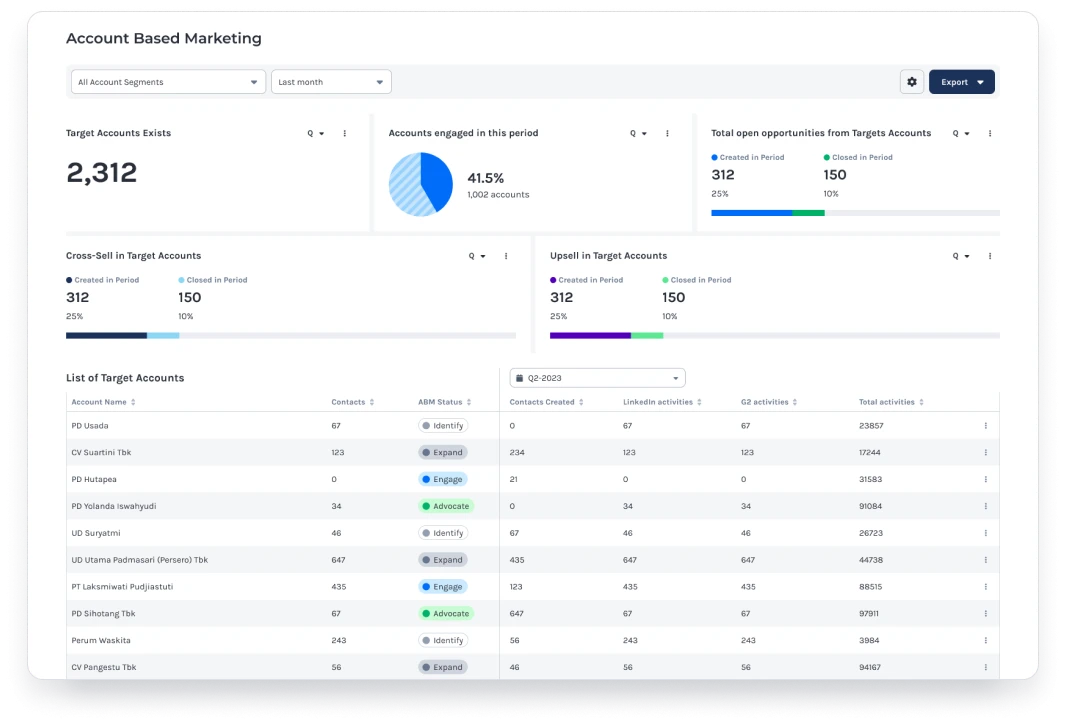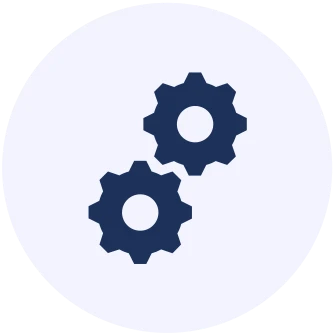The Marketing Analytics Partner to Global MOPs Teams
Drowning in data, but starved for insights?
Today, data critical to marketing teams is spread across multiple systems: Your CRM, marketing automation platform, campaign channels and more. With marketing and sales data disconnected, marketing teams face two challenges.
Firstly, with spend data locked in campaign channel platforms like Google Analytics or LinkedIn ads, it is difficult to measure the true ROI on marketing efforts and campaigns in real time.
Secondly, without a tight workflow configuration between the marketing automation and CRM systems, following the journey from lead to customer can be cumbersome.
By consolidating all marketing data in one place, Discern gives marketing teams the tools to efficiently allocate budgets with data-driven precision.

The Benefits of B2B Marketing Intelligence

Smarter Campaign Spend
Get more mileage out of your marketing budget by identifying top-performing campaigns. Discern’s advanced analytics pinpoint which channels and tactics yield the highest ROI.

Target Validation
Leverage historical performance data and granular segmentation to ensure your marketing targets align with business objectives.

Proactive Course Correction
Stay agile with real-time insights. Adjust campaign strategies early to prevent waste and boost effectiveness.

Reporting Efficiency
Forget manual data gathering. With Discern, all your marketing data is in one place, making it easy to generate actionable reports in minutes.
Case Study
The Challenge
Dotmatics’ Marketing Operations team struggled to fully automate marketing analytics within Salesforce. Challenges included tracking spend and cohorted lead conversion, making it difficult to make data-driven decisions in real time.
Discern’s Solution
Discern has allowed Dotmatics to consolidate data from various sources, track ROI, and reallocate resources to the most effective marketing efforts and campaigns.
Data Consolidation for All Marketing Data Sources
Whether you want to pull data sitting in your Marketing automation platform, CRM, campaign systems, Microsoft Excel, Google Sheets, and / or databases, Discern can support your B2B marketing analytics needs.
Discern FAQs
Pricing for Discern’s marketing analytics varies based on company and marketing program sizes. Book a meeting with our sales team to get a full demo and discuss pricing that makes the most sense for your business.
Depending on the number of connectors needed, implementation for Discern B2B Marketing analytics can vary from 2-4 weeks. Book a meeting with our team to map out the right implementation plan for your business.
Yes! Discern is proud to give customers a full view of the customer lifecycle: from marketing to sales to customer success.
Click to check out our comprehensive suite of revenue intelligence tools.
Discern is data source agnostic, so we can connect to pretty much any cloud based tool. Some of our most common integrations include:
- CRMs (Salesforce, Hubspot, Pipedrive, Zoho, etc.)
- Marketing Automation (Marketo, Hubspot, Pardot, etc.)
- Campaign Platforms (Bing Ads, Google Analytics, Google Ads, LinkedIn ads)
We are also working on integrations with ABM platforms like 6sense.
Contact us for more information on these or other integrations.
Ready to Optimize Your Marketing Investments?
Click the button below and schedule a demo to see how Discern can help your organization reduce acquisition costs and increase marketing contribution.
Industry FAQs
Analyzing lead funnel data is all about understanding how leads move through each stage of the buyer journey. You’ll want to break down your funnel into key stages—like awareness, interest, consideration, and conversion—and look at how efficiently leads progress from one to the next. Pay attention to metrics like lead volume, conversion rates, drop-off rates, and the time it takes for leads to move between stages. By identifying where leads get stuck or drop off, you can adjust your messaging, targeting, or processes to optimize conversions.
Tools like Discern’s marketing analytics platform can help by offering clear visualizations of your funnel and pinpointing exactly where you can improve to drive better results.
Marketing funnel analysis is the process of evaluating how prospects move through the different stages of the marketing funnel—from awareness to conversion. By breaking down each stage (awareness, interest, consideration, and decision), this analysis helps you identify where leads are dropping off, how efficiently they progress, and where improvements can be made. The goal is to optimize your funnel by increasing conversion rates at each stage.
Key metrics like traffic, engagement rates, conversion rates, and time-in-funnel are commonly analyzed to pinpoint where potential customers might be losing interest or where your messaging and tactics are most effective. With marketing funnel analysis, you can make more informed decisions on how to refine your campaigns, improve targeting, and ultimately drive more qualified leads to conversion.
Tools like Discern can make this process more efficient by providing clear visualizations and actionable insights into each stage of the funnel.
A lead funnel focuses on attracting, nurturing, and qualifying prospects, while a sales funnel picks up where the lead funnel leaves off—handling qualified leads and converting them into paying customers. The lead funnel is typically managed by marketing and is all about generating interest and nurturing potential customers. Once a lead is “sales-ready,” they enter the sales funnel, where sales teams focus on closing the deal. Both funnels are crucial, but they serve different functions and use distinct tactics. Analyzing both can give you a full picture of your customer journey, from initial contact to conversion.
Cohort analysis in marketing involves grouping customers or leads based on shared characteristics or behaviors over a specific time frame and then analyzing their journey through the funnel. For example, you might group users by the month they first interacted with your brand or by their acquisition channel, then track their engagement, conversion, and retention over time. This method helps you identify patterns and trends within specific groups, allowing for more tailored marketing strategies. By understanding how different cohorts perform, you can make data-driven decisions to improve targeting, messaging, and campaign timing, all of which can boost overall marketing effectiveness.





